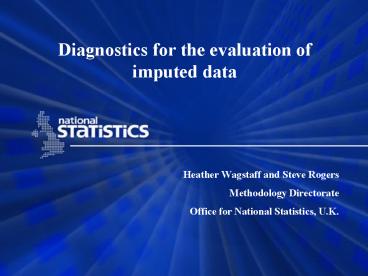Diagnostics for the evaluation of imputed data - PowerPoint PPT Presentation
Title:
Diagnostics for the evaluation of imputed data
Description:
Proposed Heuristic. Calculate the proportion of 'true' values recovered in all cases ... Evidence that the heuristic is the right approach: Stuart-Maxwell ... – PowerPoint PPT presentation
Number of Views:34
Avg rating:3.0/5.0
Title: Diagnostics for the evaluation of imputed data
1
Diagnostics for the evaluation of imputed data
- Heather Wagstaff and Steve Rogers
- Methodology Directorate
- Office for National Statistics, U.K.
2
Overview of the Presentation
- The presentation is structured as follows
- Introduction and background
- Fully controlled simulation environment
- Baseline analysis
- Limitations of selected statistical criteria
- Description of proposed heuristic
- Example application of the heuristic
- Conclusions and future work
3
Introduction and Background
- Evaluating the quality of the imputation of large
datasets - mainly tabular outputs
- ensure statistical properties maintained
- emphasis on distributional accuracy
- ? predictive accuracy lesser importance.
- ONS endorsed CANCEIS as corporate edit and
imputation tool - where the data are mainly nominal
- implementation on household individual surveys
- Registration of Life Events
- 2011 Census of Population and Households.
4
Introduction and Background
- Selected Statistical Evaluation Criteria
- Distributional accuracy
- Stuart-Maxwell significance test
- Predictive accuracy
- 1. Kappa coefficient
- 2. Large sample variance of Kappa
- 3. Proportion of true values recovered
5
Fully Controlled Simulation Environment
- Construction of synthetic data
- 1. identify reference data
- 2. analyse and record statistical properties
- 3. identify further similar data
- 2001 Area Classifications
- 4. construct truth deck to mirror reference
data - hierarchical records approx. 170K households and
400K persons - 5. introduce levels and patterns of missingness
observed in reference data.
6
Baseline Analysis
7
Limitations of the Statistical Tests
8
Limitations of Statistical Tests
9
Proposed Heuristic
Calculate the proportion of true values
recovered in all cases
10
Example Application of Heuristic
- Aim is to identify the optimal imputation
strategy - search for groupings amongst variables
- apply logistic regression to all person level
variables - identify 5 key demographic variables
- self predicting set
- but predictive power weak for two
- subject to repeated imputation and compare to
baseline.
11
Example Application of Heuristic
12
Example Application of Heuristic
13
Example Application of Heuristic
14
Conclusions and Future Work
- Evidence of instability in the chosen statistical
criteria - Stuart-Maxwell significance test
- threshold at which becomes unstable is dependent
on the marginal values and distribution of
discordant responses. - Kappa Coefficient
- is based on observed and expected values of
concordant responses (leading diagonal) - hence differing values of Kappa when same
proportion of records recovered in differing
tables.
15
Conclusions and Future Work
- Main aim to construct set of diagnostics to
facilitate 1000 repetitions of imputation process
in fully controlled simulation environment. - Evidence that the heuristic is the right
approach - Stuart-Maxwell - understand when unstable
- supported by some categorisation of the
proportion of true values recovered. - Main outcome - need to do more work!!































